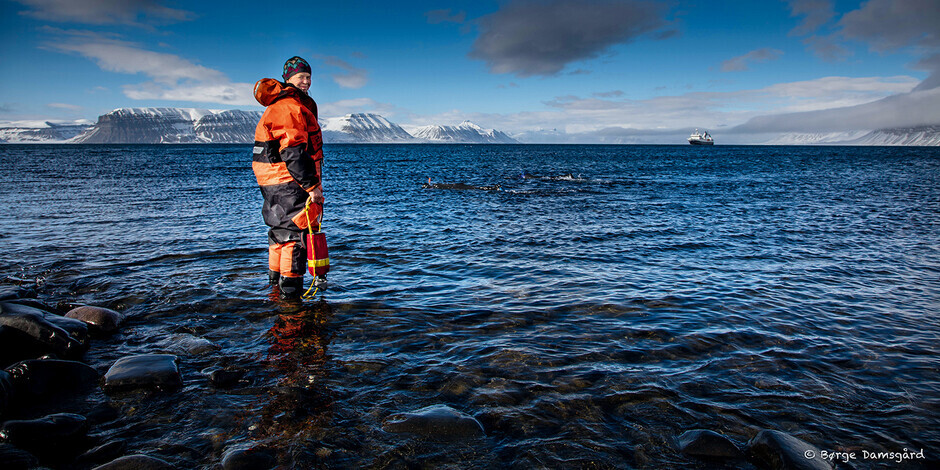Contact:
- tove.m.gabrielsen@uia.no
- Phone
- +47 38 14 11 30
- henriette.horn@uia.no
- Phone
- +47 38 14 15 74
Marine pelagic microbes include bacterioplankton as well as microbial eukaryotic organisms (protists) that inhabit the water column. They are unicellular and too small to be seen with the naked eye. Marine microbes are generally unable to swim and, therefore, drift freely with oceanic currents. They are a diverse group and include both ‘plant-like’ and ‘animal-like’ organisms. Some marine microbes are even parasitic or pathogenic. Marine microbes play a vital role in marine food webs as decomposers, as well as a food source to organisms at higher trophic levels. Therefore, it is critical to understand the dynamics of these plankton in coastal waters and their drivers of change.

Before she joined CCR, Professor Tove M. Gabrielsen helped to establish the world’s northernmost time-series station for studies of plankton dynamics in Adventfjorden, Svalbard in 2011. Professor Gabrielsen then established a time series station in Farsund, Agder upon starting her position at UiA in 2018. In addition to studying seasonal and interannual plankton diversity, function and ecology, the new time series provides an excellent opportunity for comparing temperate to Arctic marine coastal systems and, as the time series become more mature, their responses to climate change.
Overall, this research aims to improve the understanding of how organisms at lower trophic levels vary seasonally and annually, what are their environmental drivers of change, and how changes in plankton communities affect the functioning of coastal ecosystems. Such knowledge is crucial for developing models for predicting effects of climatic changes on marine ecosystems, as alterations to the dynamics of marine microbes can have severe effects for the organisms that feed on them, as well as for organisms that suffer disease due to them.
Since their establishment, data from the time series have been used in PhD and MSc projects covering aspects from microbial diversity and function, using metabarcoding and metatranscriptomics, to zooplankton ecology. The integration of students into research projects and providing research-based education has been integral to work on this topic. By contributing to research through their projects, students are included in a learning community and allowed to evolve through experience and interaction. Bridging the gap between teaching and research brings benefits to both educators and students, as exemplified by this current research on coastal plankton communities.
Refererences
Brandner, Melissa M., Eike Stübner, Adam J. Reed, Tove M. Gabrielsen, and Sven Thatje. 2017. ‘Seasonality of Bivalve Larvae within a High Arctic Fjord.’ Polar Biology 40 (2): 263–76. https://doi.org/10.1007/s00300-016-1950-x.
Kubiszyn, Anna. M., Jozef. M. Wiktor, Jozef. M. Wiktor Jr, Colin R. Griffiths, Svein Kristiansen, and Tove. M. Gabrielsen. 2017. ‘The Annual Planktonic Protist Community Structure in an Ice-Free High Arctic Fjord (Adventfjorden, West Spitsbergen).’ Journal of Marine Systems 169 (May): 61–72. https://doi.org/10.1016/j. jmarsys.2017.01.013.
Marquardt, Miriam, Ragnheid Skogseth, Ingrid Wiedmann, Anna Vader, Marit Reigstad, Finlo R. Cottier, and Tove Gabrielsen. 2019. ‘Vertical Export of Marine Pelagic Protists in an Ice-Free High-Arctic Fjord (Adventfjorden, West Spitsbergen) throughout 2011-2012.’ https://doi.org/10.3354/ AME01904.
Marquardt, Miriam, Anna Vader, Eike I. Stübner, Marit Reigstad, and Tove M. Gabrielsen. 2016. ‘Strong Seasonality of Marine Microbial Eukaryotes in a High-Arctic Fjord (Isfjorden, in West Spitsbergen, Norway).’ Applied and Environmental Microbiology 82 (6): 1868–80. https://doi.org/10.1128/ AEM.03208-15.
Vader, Anna, Haywood D. Laughinghouse, Colin Griffiths, Kjetill S. Jakobsen, and Tove M. Gabrielsen. 2018. ‘Proton- Pumping Rhodopsins Are Abundantly Expressed by Microbial Eukaryotes in a High-Arctic Fjord.’ Environmental Microbiology 20 (2): 890–902. https://doi.org/10.1111/1462-2920.14035.